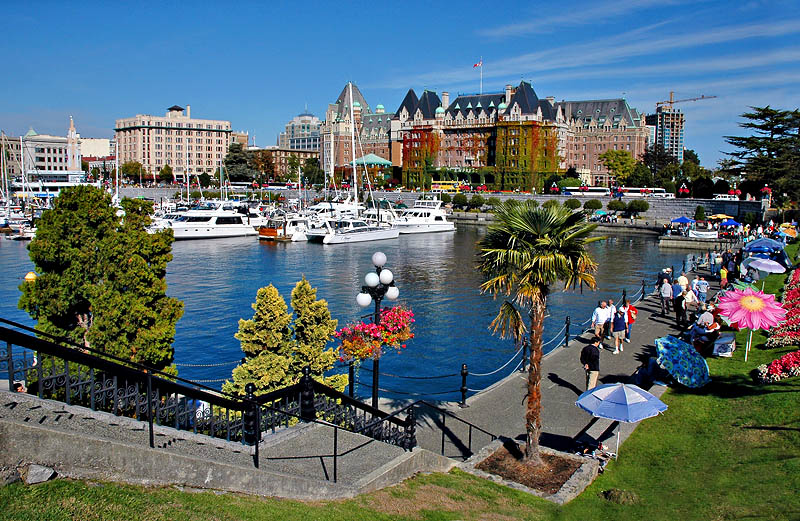
Sometimes the meaning of the message is lost in alarmist headings. That seems to be the case in this Global Television story about the City of Victoria’s Urban Forest Master Plan. Victoria currently has a tree canopy coverage of 18 percent and aims to increase that to 40 percent in the coming decades.
Street trees are remarkable in that they mitigate heat sinks, cool cities and provide much-needed shade and protection, besides their remarkable ability to photosynthesize. How street trees are chosen and placed is complex, in that as climate and local conditions change tree species that previously did well may start to decline. Diseases endemic to certain species of trees also means that street trees are planted with diversity to enable survival. And in this climate trees seem to grow beyond the nursery specifications, and seem to last longer than the anticipated life cycle in stressed conditions.
As spring rolls around citizens think of cherry trees and blossoms, and Victoria like Vancouver is well planted in cherry trees, which were very popular to plant on city streets thirty years ago. One of the challenges of cherry trees is that many species are short-lived, from 16 to 20 years. And one of the criticisms of municipal urban forest plans is that while cities emphasize the need for tree planting and replacement, there is not the education about the fact that many tree species need to be replaced as they come to the end of their life cycles, become hazardous, or invade local underground services.
In Victoria one city councillor raised the alarm about tree cutting while complaining about a spending increase of $868,000 to a tree plan and program that has a 1.7 million dollar annual budget.
But in Victoria, the tree canopy and species are the trademark of this very touristic place, and will provide much-needed heat mitigation in decades to come.This councillor pressed the alarm button for the wrong reasons. Victoria values its tree canopy benefits at over 80 million dollars and is aware that it is an aging canopy that will require diversity in a changing climate. Victoria now gets more severe weather than previously, and will require trees that can respond to those type of climatic changes.
You can take a look at the City of Victoria’s Urban Forest Master Plan here. While it will try to plant more trees that are native to the area for diversity and hardiness of stock, it will be a change of stock that will take decades, not years to enact.
Mayor Lisa Helps said a combination of development and climate change is starting to take a toll on the trees so it is “past time” for the city to make a significant investment in its urban forest.“This is the reality of climate change,” she said. “Our non-native trees, including some of the cherry blossom trees, are some of the most stressed as a result of climate change.” As the non-native trees die, they will be replaced with native species that are drought-tolerant, she said, adding that the city will be taking a more “ecosystem-based approach.“We have to deal in reality, not in fanciful thinking,” she said.
Here’s a video of what are purportedly the northern most palm trees in the western hemisphere in Beacon Hill Park in Victoria on YouTube.












How are trees native to a cooler, wetter BC going to do any better in our future hotter, drier summers than introduced species? This is just Mayor Helps tilting at yet another windmill. Also, given that street trees can negatively and expensively damage sidewalks (which is why native species were dropped) maybe shorter live trees are a more responsible choice.
Or we plan for and design boulevards wide enough to accommodate full grown trees?
Funny that this photo has a palm tree though…
Trees at value to cities and properties. They are not an expense, by and large, but an investment.
I bet it is not too hard to convince citizens to sponsor a tree, say for $1000 plus $100/year maintenance fee, if their name shows up on or near the tree ..
Trees have a certain longevity beyond the human life .. and they show growth, immortality and “I care about this city and its future” better than most donations ..
Has Victoria tried this approach, rather than raising taxes ?
It is notable that the aesthetics of street tree planting are not mentioned in Victoria’s master plan, which can be interpreted as aesthetics having no weight in the considerations. The aesthetics of urban tree planting are a significant driver in creating a beautiful streetscape. Here in Vancouver, in the name of biodiversity, we are in danger of losing beautiful arching allées, created from a single species. Recently, a healthy and magnificent street of elms was punctuated by a new tiny, columnar Dawyck Beech. Could you find anything less compatible? No one said that the same species has to be planted for kilometres, let’s just maintain the aesthetics and power of a single species planted in an architectural fashion. Aesthetics and diversity need not be in opposition.